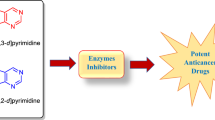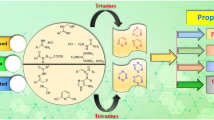Abstract
Novel gold(I) and gold(III) complexes containing derivatives of d-galactose, d-ribose and d-glucono-1,5-lactone as ligands were synthesized and characterized by IR, 1H, and 13C NMR, high resolution mass spectra and cyclic voltammetry. The compounds were evaluated in vitro for their cytotoxicity against three types of tumor cells: cervical carcinoma (HeLa) breast adenocarcinoma (MCF-7) and glioblastoma (MO59J) and one non-tumor cell line: human lung fibroblasts (GM07492A). Their antitubercular activity was evaluated as well expressed as the minimum inhibitory concentration (MIC90) in μg/mL. In general, the gold(I) complexes were more active than gold(III) complexes, for example, the gold(I) complex (1) was about 8.8 times and 7.6 times more cytotoxic than gold(III) complex (8) in MO59J and MCF-7 cells, respectively. Ribose and alkyl phosphine derivative complexes were more active than galactose and aryl phosphine complexes. The presence of a thiazolidine ring did not improve the cytotoxicity. The study of the cytotoxic activity revealed effective antitumor activities for the gold(I) complexes, being more active than cisplatin in all the tested tumor cell lines. Gold(I) compounds (1), (2), (3), (4) and (6) exhibited relevant antitubercular activity even when compared with first line drugs such as rifampicin.






Similar content being viewed by others
Abbreviations
- IR:
-
Infrared
- NMR:
-
Nuclear magnetic resonance
- TMS:
-
Tetramethylsilane
- Isop:
-
Isopropylidene
- DMF:
-
Dimethyl formamide
- HEPES:
-
4-(2-Hydroxyethyl)piperazine-1-ethanesulfonic acid, N-(2-hydroxyethyl)piperazine-N′-(2-ethanesulfonic acid)
- HMRS(ESI):
-
High-resolution mass spectra (eletrospray ionization)
- HAM-F10:
-
Nutrient mixture F-10
- DMEM:
-
Dulbecco’s modified Eagle’s medium
- XTT:
-
2,3-Bis-(2-methoxy-4-nitro-5-sulfophenyl)-2H-tetrazolium-5-carboxanilide
- DMSO:
-
Dimethylsulfoxide
- PBS:
-
Phosphate buffer saline
References
Al-Jaroudi S, Monim-ul-Mehboob M, Altaf M, Al-Saadi AA, Wazeer MIM, Altuwaijri S, Isab AA (2014) Synthesis, spectroscopic characterization, electrochemical behavior and computational analysis of mixed diamine ligand gold(III) complexes: antiproliferative and in vitro cytotoxic evaluations against human cancer cell lines. Biometals 27:1115–1136
Al-Maythalony BA, Wazeer MIM, Isab AA (2009) Synthesis and characterization of gold(III) complexes with alkyldiamine ligands. Inorg Chim Acta 362:3109–3113
Almeida MV, Cesar ET, Fontes APS, Felício ECA (2000) Synthesis of platinum complexes from sugar derivatives. J Carbohydr Chem 19:323–329
Al-Thebeiti MS (1999) Regiocontrolled incorporation and annulation of glucose into spirothiazole and spirothiazoloxazole derivatives. J Carbohydr Chem 18:667–674
Amarante GW (2005) Síntese de Compostos Anfifílicos derivados da d-Galactose, Potenciais Agentes Surfactantes. Dissertação, Universidade Federal de Juiz de Fora
Baenziger NC, Bennet WE, Soboroff DM (1976) Chloro(triphenylphosphine)god(I). Acta Cryst B 32:962
Barnard PJ, Berners-Price SJ (2007) Targeting the mitochondrial cell death pathway with gold compounds. Coord Chem Rev 251:1889–1902
Benedek TG (2004) The history of gold therapy for tuberculosis. J Hist Med Allied Sci 59:50–89
Brown FC (1961) 4-Thiazolidinones. Chem Rev 61:464–521
Bruni B, Guerri A, Marcon G, Messori L, Orioli P (1999) Structure and cytotoxic properties of some selected gold(III) complexes. Croat Chem Acta 72:221–229
Canetti J, Rist E, Grosset R (1963) Measurement of sensitivity of the tuberculous bacillus to antibacillary drugs by the method of proportions. Methodology, resistance criteria, results and interpretation. Rev Tuberc Pneumol 27:217–272
Casseta MI, Marzo T, Fallani S, Novelli A, Messori L (2014) Drug repositioning: auranofin as a prospective antimicrobial agent for the treatment of severe staphylococcal infections. Biometals 27:787–791
Chaves JDS, Neumann F, Francisco TM, Corrêa CC, Lopes MTP, Silva H, Fontes APS, Almeida MV (2014) Synthesis and cytotoxic activity of god(I) complexes containing phosphines and 3-benzyl-1,3-thiazolidine-2-thione or 5-phenyl-1,3,4-oxadiazole-2-thione as ligands. Inorg Chim Acta 414:85–90
Chen H, Jiao L, Guo Z, Li X, Ba C, Zhang J (2008) Synthesis and biological activity of novel thiazolidin-4-ones with a carbohydrate moiety. Carbohydr Res 343:3015–3020
Chirullo B, Sgarbanti R, Limongi D, Shytaj IL, Alvarez D, Das B, Boe A, Da Fonseca S, Chomont N, Liotta L, Petricoin E III, Norelli S, Pelosi E, Garaci E, Savarino A, Palamara AT (2013) A candidate anti-HIV reservoir compound, auranofin, exerts a selective ‘anti-memory’ effect by exploiting the baseline oxidative status of lymphocytes. Cell Death Dis 4:1–12
Coates GE, Kowala C, Swan JM (1966) Coordination compounds of Group IB metals. I. Triethylphosphine complexes of gold(I) mercaptides. Aust J Chem 19:539–545
Cuin A, Massabni AC, Pereira GA, Leite CQF, Pavan FR, Sesti-Costa R, Heinrich TA, Costa-Neto CM (2011) 6-Mercaptopurine complexes with silver and gold ions: anti-tuberculosis and anti-cancer activities. Biomed Pharmacother 65:334–338
Debnath A, Parsonage D, Andrade RM, He C, Cobo ER, Hirata K, Chen S, Rivera-García G, Orozco E, Martínez M, Guntilleke S, Barrios AM, Arkin MR, Poole LB, Mckerrow JH, Reed S (2012) A high throughput drug screen for Entamoeba histolytica identifies a new lead and target. Nat Med 18:956–960
Delaunay D, Toupet L, Le Corre M (1995) Reactivity of/β-amino alcohols with carbon disulfide. Study on the synthesis of 2-oxazolidinethiones and 2-thiazolidinethiones. J Org Chem 60:6604–6607
Eisler R (2003) Chrysotherapy: a synoptic review. Inflamm Res 52:487–501
Eiter LC, Hall NW, Day CS, Saluta G, Kucera GL, Bierbach U (2009) Gold(I) analogues of a platinum-acridine antitumor agent are only moderately cytotoxic bus show potent activity against Mycobacterium tuberculosis. J Med Chem 52:6519–6522
Franzblau SG, Witzig RS, McLaughlin JC, Torres P, Madico G, Hernandez A, Degnan MT, Cook MB, Quenzer VK, Fergu-son RM, Gilman RH (1998) Rapid, low-technology MIC determination with clinical Mycobacterium tuberculosis isolates by using the microplate Alamar Blue Assay. J Clin Microbiol 36:362–366
Gabbiani C, Casini A, Messori L (2007) Gold(III) compounds as anticancer drugs. Gold Bull 40:73–81
Garegg PJ (1984) Some aspects of régio-stereo-, and chemoselective reactions in carbohydrate chemistry. Pure Appl Chem 56:845–858
Gyepes A, Schaffer R, Bajor G, Woller A, Fodor P (2008) Synthesis and chromatographic study of methyl-2,3-O-isopropylidene-5-dimethyl-arsinoyl-β-d-ribofuranoside and methyl-2,3-O-isopropylidene-5-deoxy-5-dimethyl-thioarsinoyl-β-d-ribofuranoside. Polyhedron 27:2655–2661
Hickey JL, Ruhayel RA, Barnard PJ, Baker MV, Berners-Price SJ, Filipovska A (2008) Mitochondria-targeted chemotherapeutics: the rational design of gold(I) N-heterocyclic carbene complexes that are selectively toxic to cancer cells and target protein selenols in preference to thiols. J Am Chem Soc 130:12570–12571
Ingles DL, Whistler RL (1962) Preparation of several methyl d-pentothiapyranosides. J Org Chem 27:3896–3898
Lessa JA, Ferraz KSO, Guerra JC, De Miranda LF, Romeiro CFD, Souza-Fagundes EM, Barbeira PJS, Beraldo H (2012) Spectroscopic and electrochemical characterization of gold(I) and gold(III) complexes with glyoxaldehyde bis(thiosemicarbazones): cytotoxicity against human tumor cell lines and inhibition of thioredoxin reductase activity. Biometals 25:587–598
Maiore L, Cinellu MA, Nobili S, Landini I, Mini E, Gabbiani C, Messori L (2012) Gold(III) complexes with 2-substituted pyridines as experimental anticancer agents: solution behavior, reactions with model proteins, antiproliferative properties. J Inorg Biochem 108:123–127
Messori L, Marcon G (2004) Gold complexes as antitumor agents. Met Ions Biol 42:385–424
Messori L, Francesco A, Marcon G, Orioli P, Fontani M, Mini E, Mazzei T, Carott S, O’connell T, Zanello P (2000) Gold(III) complexes as potential antitumor agents: solution chemistry and cytotoxic properties of some selected gold(III) compounds. J Med Chem 43:3541–3548
Mirabelli CK, Johson RK, Sung CM, Faucette L, Muirhead K, Crooke ST (1985) Models cytotoxic properties of auranofin, a coordinated gold in vitro antitumor activity and in vivo evaluation. Cancer Res 45:32–39
Mirabelli CK, Johson RK, Hill DT, Faucette L, Girard GR, Kuo GY, Sung CM, Crooke ST (1986) Correlation of the in vitro cytotoxic and in vivo antitumor activities of gold(I) coordination complexes. J Med Chem 29:218–223
Navarro M (2009) Gold complexes as potential anti-parasitic agentes. Coord Chem Rev 253:1619–1626
Ott I (2009) On the medicinal chemistry of gold complexes as anticancer drugs. Coord Chem Rev 253:1670–1681
Ott I, Qian X, Xu Y, Vlecken DHW, Marques IJ, Kubutat D, Sheldrick WS, Jesse P, Prokop A, Bagowski CP (2009) A gold(I) phosphine complex containing a naphthalimide ligand functions as a TrxR inhibiting antiproliferative agent and angiogenesis inhibitor. J Med Chem 52:763–770
Rauter AP, Padilha M, Figueiredo JA, Ismael MI, Justino J, Ferreira H, Ferreira MJ, Rajendran C, Wilkins R, Vaz PD, Calhorda MJJ (2005) Bioactive pseudo-C-nucleosides containing thiazole, theazolidinone, and tetrazole rings. Carbohydr Chem 24:275–296
Reis RS, Ijr Neves, Lourenço SLS, Fonseca LS, Lourenço MCS (2004) Comparison of flow cytometric and Alamar Blue Tests with the proportional method for testing susceptibility of Mycobacterium tuberculosis to rifampin and isoniazid. Clin Microbiol 42:2247–2248
Releling H, Rouville E, Chittenden GJF (1987) The chemistry of d-gluconic acid derivatives. Part 1. Synthesis of 3,4;5,6-di-O-isopropylidene-d-glucitol and 2,3;4,5-di-O-isopropylidene-aldehydo-d-arabinose from d-glucono-1,5-lactone. Rec Trav Chim Pays-Bas 106:461–464
Rigobello MP, Messori L, Marcon G, Bragadin M, Folda A, Scutari G, Bindoli A (2004) Gold complexes inhibit mitochondrial thioredoxin reductase: consequences on mitochondrial functions. J Inorg Biochem 98:1634–1641
Sadler PJ, Nasr M, Narayanan VL (1984) In: Douple EB, Krakhoff IH, Hacker MP (eds) Platinum coordination complexes in cancer chemotherapy. Martinus Nijhoff Publishers, Boston, pp 290–304
Shi J-C, Chen L-J, Huang S-Y, Wu D-X, Kang B-S (1997) Chiral phosphine ligands derived from sugars 10. Syntheses, structure, characterization and activity of the gold(I) complexes with sugar-substructure phosphine ligands. J Organomet Chem 535:17–23
Shoeib T, Atkinson DW, Sharp BL (2010) Structural analysis of the anti-arthritic drug Auranofin: its complexes with cysteine, selenocysteine and their fragmentation products. Inorg Chim Acta 363:184–192
Simon TM, Kunishima DH, Vibert GJ, Lorber A (1979) Inhibitory effects of a new oral gold compound on hela cells. Cancer 44:1965–1975
Simon TM, Kunishima DH, Vibert GJ, Lorber A (1981) Screening trial with the coordinated gold compound auranofin using mouse lymphocytic leukemia P3881. Cancer Res 41:94–97
Sout EI, Doane WM, Russell CR, Jones LB (1975) Photolysis of some carbohydrate dithiobis(thioformates). J Org Chem 40:1331–1336
Sun RW-Y, Che C-M (2009) The anti-cancer properties of gold(III) compounds with dianionic porphyrin and tetradentate ligands. Coord Chem Rev 253:1682–1691
Tiekink ERT (2002) Gold derivatives for the treatment of cancer. Crit Ver Oncol Hematol 42:225–248
Trávnicek Z, Starha P, Vanco J, Hosek SJ, Suchý PJ, Prazanová G (2012) Anti-inflammatory active gold(I) complexes involving 6-substituted-purine derivatives. J Med Chem 55:4568–4579
Tsubomura T, Yano S, Kobayashi K, Sakurai T, Yoshikawa S (1986) First synthesis and characterization of platinum(II) complexes of amino sugars having anti-tumour activity; crystal structure of [ptcl2(methyl 2,3-dideoxy-α-d-mannopyranoside)] H2O. J Chem Soc Chem Commun 6:459–460
Vanitha JD, Paramasivan CN (2004) Evaluation of microplate Alamar blue assay for drug susceptibility testing of Mycobacterium avium complex isolates. Diagn Microbiol Infect Dis 49:179–180
Yoshida S-I, Kato T, Sakurada S, Kurono C, Yang J-P, Matsui N, Soji T, Okamato T (1999) Inhibition of IL-6 and IL-8 induction from cultured rheumatoid synovial fibroblasts by treatment with aurothioglucose. Int Immunol 11:151–158
Acknowledgments
The authors thank FAPEMIG, CAPES and CNPq for financial support. This work is a collaboration research project of members of the Rede Mineira de Química (RQ-MG) supported by FAPEMIG (Project: CEX—RED-0010-14).
Author information
Authors and Affiliations
Corresponding author
Rights and permissions
About this article
Cite this article
Chaves, J.D.S., Damasceno, J.L., Paula, M.C.F. et al. Synthesis, characterization, cytotoxic and antitubercular activities of new gold(I) and gold(III) complexes containing ligands derived from carbohydrates. Biometals 28, 845–860 (2015). https://doi.org/10.1007/s10534-015-9870-8
Received:
Accepted:
Published:
Issue Date:
DOI: https://doi.org/10.1007/s10534-015-9870-8




